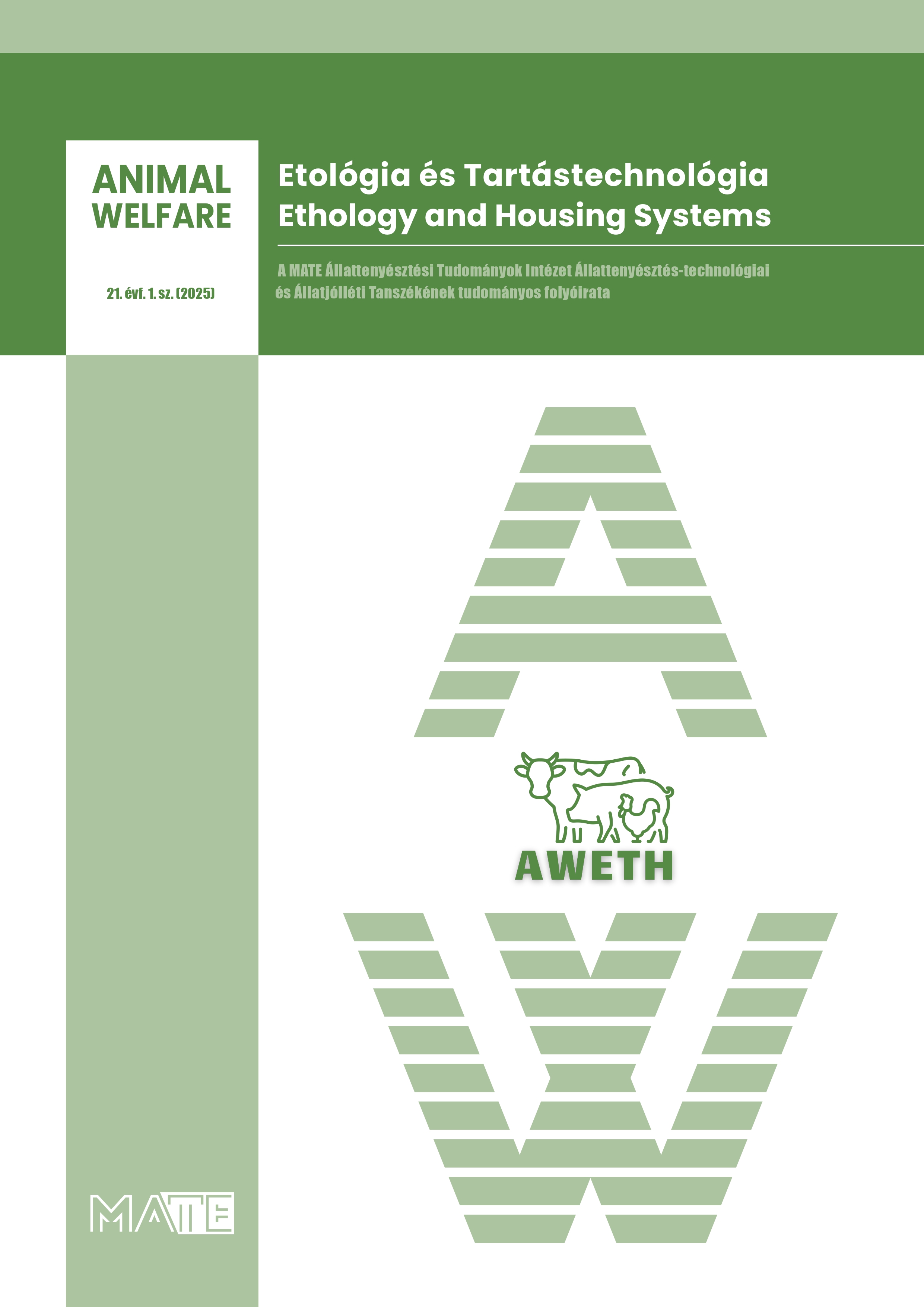Comparison of the behaviour of three strains of laboratory mice in the climbing test
DOI:
https://doi.org/10.17205/aweth.7062Kulcsszavak:
inbred mice strain, BALB/c, C57BL/6, C3H, behavioural testAbsztrakt
In our study, we tested three commonly used strains of laboratory mice in a simple behavioural test. In the climbing test, we looked at the time of the first climb and the number of climbs of the different strains during the 5-minute test time, depending on sex and age. Based on our results, neither tribe nor sex affected climbing time and the number of climbs, but different ages did. The younger animals completed the test much sooner and climbed much more often than the adult animals. Based on our results, we can say that in a more straightforward behavioural test, different mouse strains do not have as much effect as age.
Hivatkozások
Bailey, K. R., Rustay, N. R., Crawley, J. N. (2006): Behavioral phenotyping of transgenic and knockout mice: practical concerns and potential pitfalls. ILAR Journal, 47, 124–131. https://doi.org/10.1093/ilar.47.2.124
Bárdos, B., Altbacker, V., Szabó, A., Török, H. K., Nagy, I. (2023): Study of climbing ability for two closely related mouse species. The European Zoological Journal, 90(1), 395–400. https://doi.org/10.1080/24750263.2023.2217207
Bonhomme, F., Guénet, J.-L. (1996): The laboratory mouse and its wild relatives. In Lyon, M.F., Rastan, S. & Brown, S. D. M. (eds), Genetic Variants and Strains of the Laboratory Mouse. Ox-ford: Oxford University Press, pp. 1577–1596.
Bonhomme, F., Guenet, J., Dod, B., Moriwaki, K., Bulfield, G. (1987): The polyphyletic origin of laboratory inbred mice and their rate of evolution. Biological Journal of the Linnean Society, 30, 51–58. https://doi.org/10.1111/j.1095-8312.1987.tb00288.x
Bortolato, M, Godar, S. C., Alzghoul, L., Zhang, J., Darling, R. D., Simpson, K. L., Bini, V., Chen, K., Wellman, C. L., Lin, R. C. S., Shih, J. C. (2013): Monoamine oxidase A and A/B knockout mice display autistic-like features. nternational Journal of Neuropsychopharmacology, 16, 869–888. https://doi.org/10.1017/s1461145712000715
Bothe, G. W. M., Bolivar, V. J., Vedder, M. J., Geistfeld, J. G. (2005): Behavioral differences among fourteen inbred mouse strains commonly used as disease models. Comparative medicine, 55(4), 326–334. https://doi.org/10.1111/j.1601-183x.2004.00064.x
Brooke, H. M., Laura, E. S., Anisha, G., Andrew, I. S., Mathew, T. P. (2010): Phenotypic characterization of a genetically diverse panel of mice for behavioral despair and anxiety. PLoS ONE 5, e14458. https://doi.org/10.1371/journal.pone.0014458
Brown, R. Z. (1953): Social behavior, reproduction, and population changes in the house mouse (Mus musculus L.). Ecological Monographs, 23(3), 218–240. https://doi.org/10.2307/1943592
Bullock, A. E., Slobe, B. S., Vazquez, V., Collins, A. C. (1997): Inbred mouse strains differ in the regulation of startle and prepulse inhibition of the startle response. Behavioral neuroscience, 111(6), 1353. https://doi.org/10.1037//0735-7044.111.6.1353
Chesler, E. J., Wilson, S. G., Lariviere, W. R., Rodriguez-Zas, S. L., Mogil, J. S. (2002): Influences of laboratory environment on behavior. Nature neuroscience, 5(11), 1101–1102. https://doi.org/10.1038/nn1102-1101
Crabbe, J. C., Wahlsten, D., Dudek, B. C. (1999): Genetics of mouse behavior: interactions with laboratory environment. Science, 284, 1670–1672. https://doi.org/10.1126/science.284.5420.1670
Darbishire, A. D. (1902): I. Note on the Results of Crossing Japenese Waltzing Mice with European Albino Races. Biometrika, 2(1), 101–113. https://doi.org/10.1093/biomet/2.1.101
Darbishire, A. D. (1903): Second report on the result of crossing Japanese waltzing mice with European albino races. Biometrika, 2(2), 165–173. https://doi.org/10.1093/biomet/2.2.165
Darbishire, A. D. (1904): On the result of crossing Japanese waltzing with albino mice. Biometrika, 3(1), 1–51. https://doi.org/10.1093/biomet/3.1.1
DeFries, J. C., Weir, M. W., Hegmann. J. P. (1967): Differential effects of prenatal maternal stress on offspring behavior in mice as a function of genotype and stress. Journal of Comparative and Physiological Psychology, 63, 332–332. https://doi.org/10.1037/h0020842
Grant, S., O’Dell, T., Karl, K., Stein, P., Soriano, P., Kandel, E. (1992): Impaired long-term potentiation, spatial learning, and hippocampal development in fyn mutant mice. Science, 258, 1903–1910. https://doi.org/10.1126/science.1361685
Haisová-Slábová, M., Munclinger, P., Frynta, D. (2010): Sexual size dimorphism in free-living populations of Mus musculus: are male house mice bigger. Acta Zoologica Academiae Scien-tiarum Hungaricae, 56(2), 139–151.
Izidio, G. S., Lopes, D. M., Spricigo, L., Ramos, A. (2005): Common variations in the pretest environment influence genotypic comparisons in models of anxiety. Genes, Brain and Behavior, 4(7), 412–419. https://doi.org/10.1111/j.1601-183x.2005.00121.x
Kammenga, J. E. (2017): The background puzzle: how identical mutations in the same gene lead to different disease symptoms. The FEBS journal, 284(20), 3362–3373. https://doi.org/10.1111/febs.14080
Kim, D., Chae, S., Lee, J., Yang, H., Shin, H. S. (2005): Variations in the behaviors to novel objects among five inbred strains of mice. Genes, Brain and Behavior, 4, 302–306. https://doi.org/10.1111/j.1601-183x.2005.00133.x
Kirby, A., Kang, H. M., Wade, C. M., Cotsapas, C., Kostem, E., Han, B., Furlotte, N., Kang, E. Y., Rivas, M., Bogue, M. A., Frazer, K. A., Johnson, F. M., Beilharz, E. J., Cox, D. R., Eskin, E., Daly, M. J. (2010): Fine mapping in 94 inbred mouse strains using a high-density haplotype resource. Genetics, 185(3), 1081–1095. https://doi.org/10.1534/genetics.110.115014
Koide, T., Moriwaki, K., Uchida, K., Mita, A., Sagai, T., Yonekawa, H., Katoh, H., Miyashita, N., Tsuchiya, K., Nielsen, T. J., Shiroishi, T. (1998): A new inbred strain JF1 established from Japanese fancy mouse carrying the classic piebald allele. Mammalian Genome, 9, 15–19. https://doi.org/10.1007/s003359900672
Korte, S. M., De Boer, S. F. (2003): A robust animal model of state anxiety: fear-potentiated
behaviour in the elevated plus-maze. European journal of pharmacology, 463(1–3), 163–175. https://doi.org/10.1016/s0014-2999(03)01279-2
Lisk, R. D., Pretlow 3rd, R. A., Friedman, S. M. (1969): Hormonal stimulation necessary for elicitation of maternal nest-building in the mouse (Mus musculus). Animal Behaviour, 17, 730–737. https://doi.org/10.1016/s0003-3472(69)80020-5
Little, C. C., Tyzzer, E. E. (1915): Further experimental studies on the inheritance of susceptibility to a transplantable tumor, carcinoma (J.w.A.) of the Japanese waltzing mouse. The Journal of Medical Research, 33, 393–427.
Mistry, A. M., Thompson, C. H., Miller, A. R., Vanoye, C. G., George Jr, A. L., Kearney, J. A. (2014): Strain-and age-dependent hippocampal neuron sodium currents correlate with epilepsy severity in Dravet syndrome mice. Neurobiology of disease, 65, 1–11. https://doi.org/10.1016/j.nbd.2014.01.006
Morice, E., Denis, C., Giros, B., Nosten‐Bertrand, M. (2004): Phenotypic expression of the target-ed null‐mutation in the dopamine transporter gene varies as a function of the genetic background. European Journal of Neuroscience, 20(1), 120–126. https://doi.org/10.1111/j.1460-9568.2004.03465.x
Potter, M. (1978): Comments on the relationship of inbred strains to the genus Mus. In Origins of inbred mice. New York: Academic Press, pp. 497–509. https://doi.org/10.1016/b978-0-12-507850-4.50045-7
Schauwecker, P. E. (2011): The relevance of individual genetic background and its role in animal models of epilepsy. Epilepsy research, 97(1–2), 1–11. https://doi.org/10.1016/j.eplepsyres.2011.09.005
So, M., Imai, Y. (1920): The types of spotting in mice and their genetic behaviour. Journal of Genetics, 9, 319–333. https://doi.org/10.1007/bf02983567
Sprott, R. L., Eleftheriou, B. E. (1974): Open-Field Behavior in Aging Inbred Mice. Gerontology, 20, 155–162. https://doi.org/10.1159/000212009
Strong, L. C. (1935): The establishment of the C3H inbred strain of mice for the study of spontaneous carcinoma of the mammary gland. Genetics, 20(6), 586.
Suckow, M. A., Danneman, P., Brayton, C. (2001): The laboratory mouse. CRC Press, New York.
Tokuda, M. (1935): An eighteenth century Japanese guide book on mouse breeding. Journal of Heredity, 26(12), 481–484. https://doi.org/10.1093/oxfordjournals.jhered.a104011
Tyzzer, E. E. (1915): The tumors of the Japanese waltzing mouse and of its hybrids. The Journal of Medical Research, 32, 331–360.
van de Lagemaat, L. N., Stanford, L. E., Pettit, C. M., Strathdee, D. J., Strathdee, K. E., Elsegood, K. A., Fricker, D. G., Croning, M. D. R., Komiyama, N. H., Grant, S. G. (2017): Standardized experiments in mutant mice reveal behavioural similarity on 129S5 and C57BL/6J backgrounds. Genes, Brain and Behavior, 16(4), 409–418. https://doi.org/10.1111/gbb.12364
Wade, C. M., Kulbokas III, E. J., Kirby, A. W., Zody, M. C., Mullikin, J. C., Lander, E. S., Lindblad-Toh, K., Daly, M. J. (2002): The mosaic structure of variation in the laboratory mouse genome. Nature, 420, 574–578. https://doi.org/10.1038/nature01252
Yerks, R. M. (1907): The Dancing Mouse. New York, The Macmillan Company.
Yonekawa, H., Moriwaki, K., Gotoh, O., Watanabe, J., Hayashi, J. I., Miyashita, N., Petras, M. L., Tagashira, Y. (1980): Relationship between laboratory mice and the subspecies Mus musculus domesticus based on restriction endonuclease cleavage patterns of mitochondrial DNA. The
Japanese Journal of Genetics, 55(4), 289–296. https://doi.org/10.1266/jjg.55.289
Young, K. A., Berry, M. L., Mahaffey, C. L., Saionz, J. R., Hawes, N. L., Chang, B., Zheng, Q. Y., Smith, R. S., Bronson, R. T., Nelson, R. J., Simpson, E. M. (2002): Fierce: a new mouse deletion of Nr2e1; violent behaviour and ocular abnormalities are background-dependent. Behavioural brain research, 132(2), 145–158. https://doi.org/10.1016/s0166-4328(01)00413-2
Letöltések
Megjelent
Folyóirat szám
Rovat
License
Copyright (c) 2025 Henrietta Kinga Török, Boróka Bárdos, Orsolya Ivett Hoffmann

This work is licensed under a Creative Commons Attribution-NonCommercial-NoDerivatives 4.0 International License.
A folyóirat a nyílt hozzáférés elvei szerint működik, cikkeire ugyanakkor a Creative Commons 4.0 standard licenc alábbi típusa vonatkozik: CC-BY-NC-ND-4.0. Ennek értelmében a mű szabadon másolható, terjeszthető, bemutatható és előadható, azonban nem használható fel kereskedelmi célokra (NC), továbbá nem módosítható és nem készíthető belőle átdolgozás, származékos mű (ND). A licenc alapján a szerző vagy a jogosult által meghatározott módon fel kell tüntetni a szerző nevét és a szerzői mű címét (BY).














